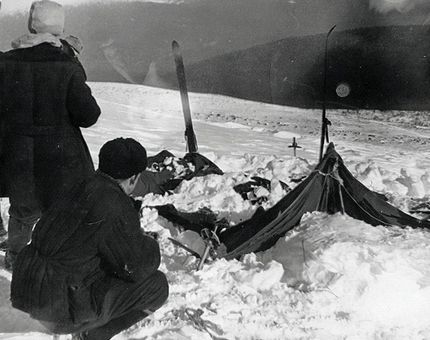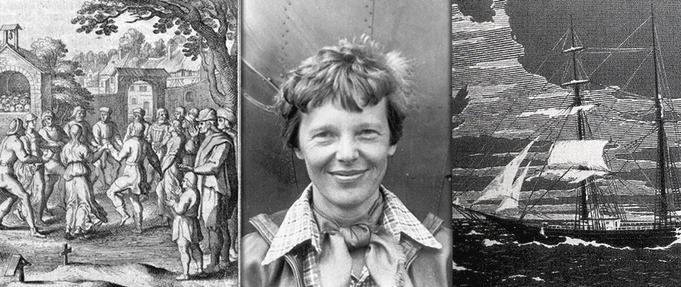We’ve learned a lot over the years, but no matter how much we learn, it seems that there’s always so much more we don’t know. As we shine lights into dark corners of history, we find that the light casts darker shadows still, as is the case with these eerie unsolved mysteries from throughout the ages. From ghost ships to mysterious explosions, from a bridge that seemingly lures dogs to their deaths to a dancing plague that once gripped Europe, these mysteries are some of the strangest and most haunting you will ever find—and they may never be solved!
The Amber Room
Once dubbed the “Eighth Wonder of the World,” this room was a gift to Peter the Great designed to commemorate peace. Made from over six tons of amber and other precious gemstones, the Amber Room’s primary components were large amber wall panels backed with gold leaf. In 1941, the Nazis moved into the Soviet Union, looting thousands of art pieces along the way—including the Amber Room, which they packed into 27 crates and shipped to what was then Konigsberg, Germany.
That’s where the mystery begins. By 1944, Allied bombing runs had destroyed much of Konigsberg. Did the Amber Room perish in the bombings, as well? Some believe it did, while others think that the room was packed up and shipped someplace else. Ultimately, the fate of the room remains a mystery, though in 1979, a reproduction was built in St. Petersburg, where it still stands today.

The Mary Celeste
In December of 1872, a Canadian ship found this brigantine adrift and deserted off the Azores. She was still seaworthy, and her cargo remained intact, but one of her lifeboats was missing. Of her crew, there was no sign—and none were ever seen again. What became of the people who were onboard the Mary Celeste?
It’s a question that has fascinated countless would-be sleuths for more than a hundred years, becoming the focus of stories, films, and documentaries involving such illustrious names as Arthur Conan Doyle and Bela Lugosi—so much so that the name of the ship herself has become synonymous with maritime mystery. Numerous possible solutions have been proposed over the years, including a 2006 experiment suggesting that a “pressure-wave type of explosion” might have been the culprit behind the crew’s disappearance, but no one really knows the answer for sure.
The Lost Colony of Roanoke
On August 27, 1587, John White left more than a hundred colonists behind on Roanoke Island while he returned to England to restock supplies and plead for help for the ailing colony. The intention was for him to return right away, but the Anglo-Spanish War delayed a relief ship by three years. By the time it did arrive, it found the colony fortified but abandoned, the only clue as to the fate of its former inhabitants the word “CROATOAN” carved into the palisades. What does it mean? At the time, it was believed that the colonists had relocated to nearby Croatoan Island. However, White’s expedition wasn’t able to check before they were forced back to England by rough seas and unfortunate misadventure. So the fate of the colonists remains unknown to this day, when William Kelso of the Jamestown Rediscovery Foundation has called it “the biggest unsolved mystery in American history.”
The Tunguska Event
In 1908, locals in an isolated part of Siberia observed a bluish light, nearly as bright as the sun, followed by a flash and a shock wave powerful enough to knock people off their feet and shatter windows hundreds of miles away. When the epicenter of the blast was finally investigated, observers found trees leveled over an area of some 830 square miles—the result of an explosion equivalent to anywhere from three to 50 megatons. What could have caused such devastation in 1908? Theories over the years have been many, ranging from alien spacecraft to micro black holes. The most likely answer, however, is a meteor air burst, in which an asteroid explodes upon entering the atmosphere but before reaching the planet’s surface.
The Dancing Plague of 1518
Sometime in 1518, a woman began dancing in the streets of Strasbourg, in what is now present-day France. Before long, others had joined in and, before the so-called “dancing plague” abated, as many as 400 people may have been involved. According to some later accounts, some of those affected may even have danced themselves to death, with as many as 15 people per day dropping dead at the height of the plague—though skeptics point out that such death tolls are only mentioned in later accounts, not any surviving ones from the time of the outbreak.
However many people were involved and whatever became of them, we know that they began inexplicably dancing, and continued to do so long enough that the local authorities became involved. Why? We don’t know, though modern theories suggest everything from stress-induced mass hysteria to ergot poisoning.

The Disappearance of Amelia Earhart
Amelia Earhart was already a trailblazing aviation pioneer and global celebrity when she began her proposed mission to become the first woman pilot to circumnavigate the globe. Accompanied only by her navigator Fred Noonan, she set off for her fateful flight on June 1, 1937. Her planned route would encompass some 29,000 miles—at the time, the longest such flight ever attempted. Unfortunately, Earhart was destined to become more famous for her failure than she ever had for her successes.
On July 2, with only a few thousand miles left of her planned route, Earhart’s plane disappeared somewhere near Howland Island, halfway between Australia and Hawaii. What became of Earhart and her navigator? No one knows, though the most likely answer is that they crashed somewhere in the Pacific Ocean. However, Earthart’s plane and the remains of its two occupants have never been found.
The Overtoun Bridge
In 1895, a bridge was completed to extend the driveway of Scotland’s Overtoun House across a steep ravine. With three arches, the bridge may be a lovely piece of architecture, but it has acquired a sinister reputation. Since 1950, as many as 300 dogs have reportedly jumped from the bridge, with at least 50 of them dying in the resulting fall onto the rocks some 50 feet below. What makes the dogs jump?
Skeptics posit that the dogs may be tricked by optical illusions or lured by the scent of minks in the ravine below the bridge—while others suggest that the bridge itself may be the site of some kind of paranormal phenomena that has rendered it what some locals call the “Bridge of Death.”
The Dyatlov Pass Incident
In February of 1959, nine experienced ski hikers went missing in Russia’s Ural Mountains. By the time they were found, all nine were dead, most of them from hypothermia. But it was the circumstances surrounding their deaths that made the whole thing so mysterious. Their tent had been torn or cut open from the inside, and they had seemingly fled its shelter in a state of partial undress—certainly not geared up for the extreme temperatures they would face outside. Some were wearing socks, or only one shoe.
Furthermore, while most of the bodies appeared to have died from hypothermia, three had experienced fatal injuries, ones that “no man could have inflicted,” according to a doctor who examined the bodies. “It was equal to the effect of a car crash.” Theories about what happened range from flying saucers to sudden avalanches, but to this day, no one really knows…

The Voynich Manuscript
Handwritten in an unknown script, decorated with drawings of plants that don’t seem to exist in nature, the so-called Voynich Manuscript is a mystery—or possibly a hoax—dating back to the early 15th century. We know that much, at least, because the pages and ink have been carbon-dated. Almost everything else about the manuscript, however, remains an enigma. Composed of around 240 vellum pages, the manuscript is named for Wilfrid Voynich, a Polish book dealer who purchased it in 1912 and helped to propel its mystery into worldwide fame.
Though it has been extensively studied by both professional and amateur historians and codebreakers, no one has been able to definitively determine just what the book is, where it came from, or what it’s supposed to say.
.jpg?w=32)
